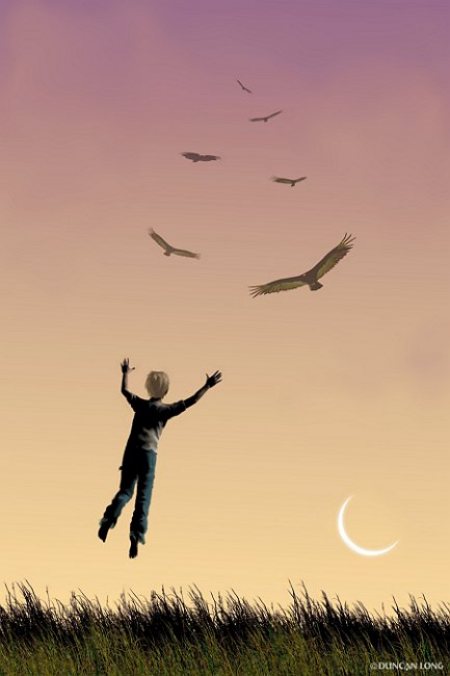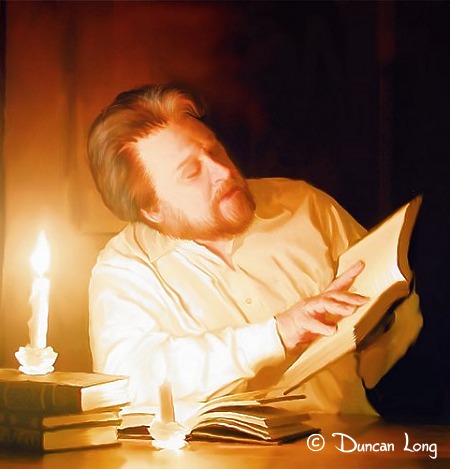You’re Creative. You’re Different.
filed in Creativity on Nov.21, 2011

The Dream - Book illustration by Duncan Long
Creative people often feel highs of joy and lows of sorrow that others may never experience, and perhaps could not even handle if they did. Little wonder many outside the creative world mistake (or dismiss) eccentric responses of the spirit as weakness or mental illness.
But in the end, these dismissive souls will never know what it is to be moved to tears by the beauty of rose or brought to joy by sunlight filtering through the leaves of spring or autumn.
The creative walk in glades invisible to those outside their realms.
If you’re creative (or live with someone who is), here are three links that may be of interest:
The Unleashed Mind: Why Creative People Are Eccentric by Dr. Shelley Carson
And an except from the musical Sunday In The Park With George in which the main character sings about the compulsion to complete work rather than have a life: Finishing the Hat
Finally, the guest post I did for Dr. Shelly Carson’s Blog (with some interesting comments by Carson and others).

"The Narrator" an illustration by artist Duncan Long
I want to make it clear that I don’t feel creative people are necessarily superior to those around them. Only that they’re different. Sometimes this difference is a plus. Often it’s a handicap.
The creative brain operates in ways very similar to synesthesia, a neurological condition in which one sensory pathway bleeds over into another so that a person may see a color when reading a certain number, or smell music, etc. The difference is that many creative people have emotional areas of the brain tied into visual or other parts that are not normally connected, so that a beautiful flower, sunset, or whatever may also trigger an emotional response. Thus while a non-creative person might be somewhat moved by, say, a bird singing, a highly creative person with the interwoven brain pathways may experience a rush of very complex emotions sparked by a bird song.
The extra circuitry within the creative brain also makes it easier to “see” relationships between ideas, objects, and so forth (perhaps relationships that indeed aren’t really there). These new-found associations can then act as a springboard to new ideas.
Also worth noting, like those suffering from synethesia, creative children are often hounded into hiding the feelings, ideas, and emotions sparked by their brain activity due to teachers (and peers) who tag creatives as “emotional,” “overly sensitive,” “tenderhearted,” and the like. The bravest creatives soldier on to become writers, artists, and musicians; the weaker or most abused likely fall to the way side, beaten into submission by the bean counters of the world.
At least that’s my very, very biased view and likely less than scientific take on the situation.
====================
When not pondering creativity, Duncan Long works as a book cover artist creating illustrations like those show above. Over 1,000 of his illustrations have appeared on book covers or in books from HarperCollins, PS Publishing, Pocket Books, ILEX, Asimov’s Science Fiction, Moonstone Books, and many other presses and self-publishing authors. See more of Long’s book illustrations at: Duncan’s Book Illustration Portfolio
=====================
November 21st, 2011 on 1:14 pm
In the beginning of the post you say ‘mental illness’ as if it’s a bad thing XD
November 21st, 2011 on 1:27 pm
@ Mindy: I certainly don’t aim to belittle or otherwise take away from those who suffer from mental illness. However whether you’re talking physical or mental illness, most societies view any “illness” as a negative thing.
Any illness may ultimately lead to a stronger person, or force them to develop other skills to cope with their problems. But in the end, I doubt that few who suffer from mental illness would argue that it is a good experience or something they’d not prefer to be unencumbered with.
At least that’s my take on things.
November 21st, 2011 on 3:24 pm
Never thought about seeing a color when reading a certain number. And I did not know about synesthesia. I do know that I have certain emotional responses when I see things that remind me of my Mom – like hummingbirds or a beautiful garden or a lady bug. Good post, Duncan. Sharing.
November 21st, 2011 on 3:33 pm
I would like to think my children might think of me when seeing hummingbirds or flowers in a garden. But I suspect they tend to think of me more when spying a cockroach skittering for cover :o)
November 21st, 2011 on 3:51 pm
Ever since I first heard of synethesia I’ve wanted to have it. Not that you can order it from the store, but still. I have always felt certain things should be certain colors, and images and sounds have strong associations for me. Sometimes I am so taken with a picture or a strand of music, I say to someone else, “Look! Isn’t that amazing!” and I have so much to say, but the other person looks at me as if I’m delusional.
But I can never decide if I’m “different” or if other people just hide responses like that more or if that part of themselves has been closed off for too long or if I’m just weird and seeing things that are not there.
And like that song, I’d rather complete a work than have a life. Hmm. No. Completing a work is just a valid a life as hanging out and watching tv, isn’t it?
November 21st, 2011 on 3:57 pm
That “Look isn’t that amazing!” with no reaction from those you’re with is pretty common to creative people, I think. And by and large, no, they’re not hiding any emotions or feelings on this. There just are none there.
(An artist friend and I often laugh at how we seem to be in a different dimension from those around us, able to see and feel things that are invisible to them — of course on the flip side, others likely see us as a “bit off.”)
Of course this begs the question as to whether creative people feel general emotions more deeply than non-creative folks. I suspect not but sometimes wonder if this is not the case.
November 22nd, 2011 on 10:29 am
Awesome thoughts!
November 22nd, 2011 on 10:31 am
Interesting thoughts but — I LOVE THESE PICS!!!
November 22nd, 2011 on 3:31 pm
Fascinating ideas and insights. Thanks for sharing these.
November 22nd, 2011 on 5:45 pm
The sooner creative people realize they are a different breed of cat, the sooner they can get on with their life. Thanks for helping wake young creative people.
November 23rd, 2011 on 2:58 am
Totally interesting article. And your book illustrations and artwork are great as well.
November 25th, 2011 on 2:06 pm
Great article — and fantastic book illustrations. Also, happy (late) thanksgiving :).
November 26th, 2011 on 3:56 am
We are different cats. Some good advice and thoughts. And you’re creating some beautiful book illustrations as well!